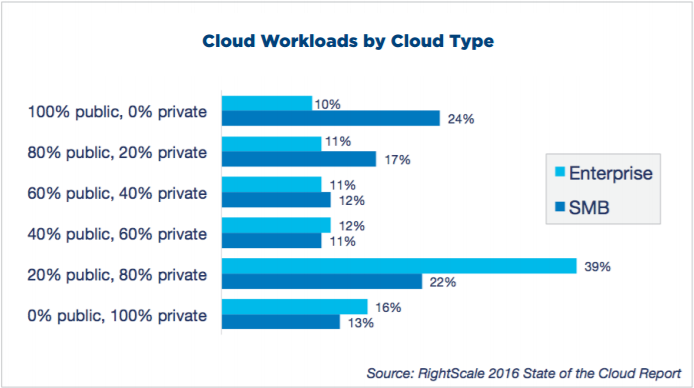
These days, companies cannot grow successfully without planning an IT infrastructure strategy. If that infrastructure fails, the company fails. It seems that most organizations are coming to the conclusion that a hybrid cloud model is the best option. According to the 451 Alliance, around 70% of organizations are currently using a multi-cloud model. RightScale’s 2016 State of the Cloud Report shows similar results with 71% of companies using a hybrid cloud model. Adoption of a hybrid cloud model increased by roughly 12% year over year.
Hybrid Cloud vs Multi-Cloud
First of all, to make sense of these reports and other articles that discuss cloud strategy, it’s important to understand the difference between hybrid cloud and multi-cloud. A multi-cloud model simply means using multiple clouds. A company could use a variety of public clouds and be considered multi-cloud. They could likewise use only private clouds and be considered multi-cloud. A hybrid cloud model consists of two or more clouds of which at least one is public and one is private. However, trends in hybrid cloud architecture vary by the size of the organization.
Hybrid Cloud Strategy for SMBs
Over half of SMBs run the majority of their workload in a public cloud. According to RightScale’s 2016 State of the Cloud Report, almost a quarter of SMBs run 100% of their workload in a public cloud. This infrastructure strategy can make sense for start-ups and small businesses because it doesn’t require much capital to get started.
However, starting to consider a small private cloud as soon as possible can be beneficial for growing businesses. According to Avi Freedman, the earlier a company starts to think about this the better. Avi Freedman started Philadelphia’s first ISP in 1992, is the former Chief Network Scientist for Akamai, and is now co-founder and CEO of Kentik, Inc. He shared some valuable insights with First Round’s startup community in a detailed article on top infrastructure mistakes. According to the article, he often hears about companies getting stuck in “cloud jail”. He says, “It’s a story I see repeat itself over and over.” The article explains, “…[these companies] would have preferred to run a “hybrid” of some cloud-based infrastructure and their own servers — or at the very least a multi-cloud system.” In conclusion, SMBs that use a hybrid cloud model where at least a small portion of their workload or data is set up in a private cloud have an advantage. They are more agile and more prepared for growth.
Hybrid Cloud Strategy for the Enterprise
On the opposite end of the spectrum, 16% of enterprises run 100% of their workloads on private clouds, according to the 2016 State of the Cloud Report. Over half of enterprises run the majority of their workload on private clouds.
Enterprises tend to lean toward having some private cloud infrastructure because it can save them money as their data and workload grows. Avi Freedman gives a prime example in the same article mentioned above: He helped a company move 500TB and 10 gigabits/sec of streaming from their public cloud provider to their own infrastructure, and in the process brought their bill to under $100,000/month. Today, they spend $250,000/month for infrastructure and bandwidth and estimate that their Amazon bill would be well over $1,000,000/month if they had continued using the public cloud.
According to the State of the Cloud Report, leveraging a hybrid cloud model is the top priority for enterprise IT, and clearly enterprises are seeing the most benefit from a hybrid model. Enterprises plan to continue to increase email, collaboration and business application workloads in the public cloud via SaaS.
Supporting a Hybrid Model with Colocation
Data Foundry supports a hybrid cloud environment by helping our customers support their own IT infrastructure. We also rent equipment to customers who aren’t ready to buy their own but still want to run some infrastructure on their own. We enable secure access to a public cloud through our CloudTap® service which allows customers to have a dedicated connection to top cloud providers such as AWS, Azure and Google Cloud.

